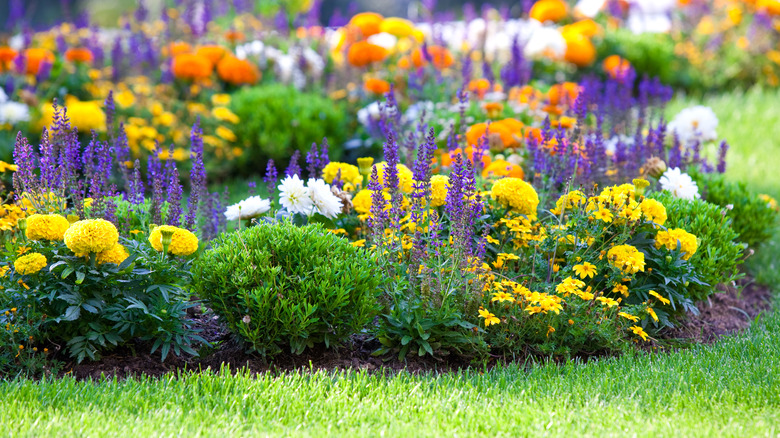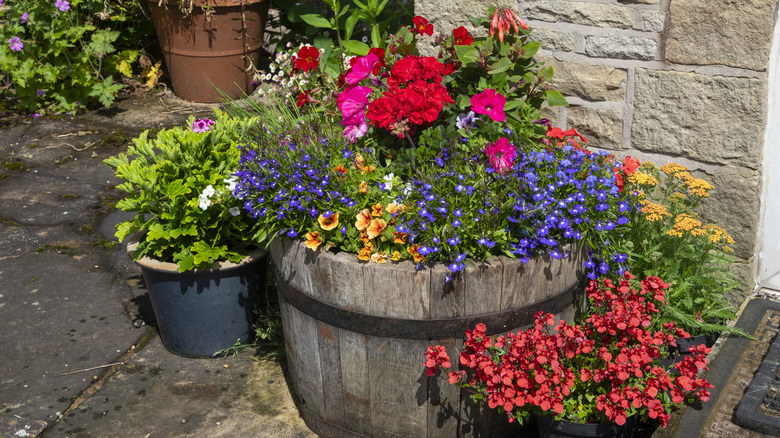12 Front Yard Flower Bed Ideas To Camouflage An Unsightly Garage Or Driveway
Flower beds make great decorative features in a yard. But sometimes they're placed next to things that aren't so attractive, like that cracked driveway or that garage that needs a fresh coat of paint. If you'd rather be gardening than doing home improvement projects (hey, who wouldn't?), why not focus your energy on flower beds as design solutions? There are some tricks for creating flower beds that will help distract the eye from an unsightly garage or driveway.
It's possible to plant flower beds and shrubs to actually try and hide the driveway or garage from view, but this isn't necessarily practical. But camouflage need not only refer to hiding things; it can also mean drawing the eye to other features by making them more prominent. Landscaping and garden design can be way to bring visual impact that not only enhances a house, but also creates a unified look for the entire property. Trees, shrubs, flower beds, and other decor can be as much a part of a home's personality as the house itself.
Before adding a new flower bed, step back and take a look at the existing landscaping and layout of your garden. Notice where and what your eyes are drawn to, then decide where you want focal points to be, and what you'd like to see there. Also consider how much time you have for maintenance. You may want a subdued look with neatly trimmed shrubs, or a colorful three season flower bed, but remember both looks require some upkeep.
Foundation plantings
Foundation plantings are a common feature of landscape design. This refers to plantings that surround a house or building — next to doors, beneath windows, or in front of the foundation. These plantings create a visual transition between the house and the rest of the property, defining its look and feel. They can also hide flaws (like poorly placed electrical meters) and soften harsh lines by adding rounded, organic shapes. Connecting a flower bed to foundation plantings, along a walkway, for example, draws the eye across the entire area, and away from the driveway or garage.
Colorful blooms
Color is perhaps one of the most powerful visual elements in a garden designer's toolbox. Using similar flower color palettes in separate garden beds will link the areas together visually and beckon the eye to look at them. The English garden designer Gertrude Jekyll pioneered the idea of color "drifts" in the garden, planting long, narrow patches of flowers to create pleasing vistas. Using contrasting color combinations (like purple and yellow, burgundy and chartreuse, orange and blue) or a gradation of related colors side by side (for example, orange, red, magenta, purple, blue) both create a very eye-catching display.
Contrasting colors, shapes, textures
You can create very simple, but striking, combination plantings by paying attention to simple design principles like color, shape, and texture. This lets you achieve maximum visual impact (diverting attention from that less-than-lovely garage door) with fewer plants and less maintenance. Include plants that are tall and narrow, rounded, and some with more free-flowing organic shapes. Combine smooth, glossy leaves (boxwood, rhododendron, azalea) with feathery, textured leaves (juniper, ferns, yarrow, artemisia). Choose shrubs with dramatically different colors of foliage and flowers for a dramatic, dynamic display.
Evergreens
Evergreens are a wonderful investment for the home landscape, providing four seasons of color and interest. They come in a vast assortment of varieties, with a wide range of sizes, shapes, textures, and colors. Evergreens need full sun and well-draining soil, and some need consistent pruning, but otherwise they are fairly low maintenance and adaptable. Evergreen shrubs as hedges and foundation plantings were once very popular, but now there's a growing trend to use evergreens as part of a more varied landscape design. This works well with dwarf and low-growing cultivars of evergreen shrubs like boxwood, juniper, and spruce.
Flowering shrubs
Flowering shrubs are a great way to camouflage things and also create a large spot of seasonal color in the landscape. There are flowering shrubs for spring, summer, and fall, allowing you to design for multiple seasons of bloom. Learn their growing habits and needs (sunlight, soil, and moisture), and make sure they're the right size for your space once they reach maturity. Some of the most showy but low maintenance flowering shrub varieties include panicle hydrangea, lilac, azalea, amsonia, butterfly bush, weigela, rose of Sharon, and Korean spice viburnum.
Hanging baskets
Hanging flower baskets can be a wonderful addendum to your flower beds, lending height and drawing the eye upward when the vibrancy of flower beds may wax and wane during the blooming season. Curving metal hooks that can be inserted into your siding — they make it easy to install hanging baskets in various places. Choose colorful, trailing annuals (like calibrachoa, petunias, nasturtiums, lobelia, fuschia, or begonias) for a diverting, dramatic display that will flower all season long. Water them well and remove spent flowers to keep them fresh and thriving.
Annuals in containers
Annuals in containers will often bloom all season long, only needing water and a bit of deadheading for maintenance. Containers offer flexible placement, too. Arrange containers near your driveway or by the garage to camouflage a drab area. Annuals with flowing or cascading movement are especially eye-catching, like begonias, fuchsia, lobelia, or "wave" petunias. Showy, long-blooming annuals include marigolds, portulaca, verbena, and Gerbera daisies. Coleus is easy to grow and has colorful foliage that stays vibrant all season: Be sure to trim off the flower stalks to allow the plant's energy to focus on the leaves.
Annuals in flower beds
Planting annuals in your flower beds adds eye-catching color all season long. Try tall, dramatic annuals like cannas, zinnias, cosmos, or sunflowers; or low-growing trailing varieties like petunias, alyssum, portulacas, and verbena. You can plant annuals amongst your perennials or put them in containers to lure eyes to your flower beds. Make sure you allow for adequate drainage by placing the container over a couple of bricks or pavers, not directly on soil. Some annuals in containers may fade in intense summer heat, so water them regularly, and place them in dappled shade for protection.
Window boxes and fence planters
Getting a new fence installed can be expensive. If the main thing camouflaging your driveway or garage is an old wooden fence, why not spruce it up with some planters and window boxes? There are hanging metal planters with coir mats that hook right over most fences, or if you're handy with a hammer, you can try attaching some wooden window boxes. This is a great rustic look that complements cottage gardens. Be sure to create good drainage by drilling some holes or lining containers with pebbles.
Cascading color
One way to camouflage straight edges or a drab driveway is to plant flowers that have trailing or cascading blooms that will spill over beds or containers. This creates an illusion of height, softens harsh edges and lines with free-flowing organic growth, and provides distracting bursts of color. Some excellent cascading perennial flowers include bellflowers, creeping phlox, lamium, and perennial flax. Annuals that have lovely cascading flowers all season include nasturtiums, wave petunias, lobelia, lantana, alyssum, and verbena.
Colorful foliage
Color is obviously a major feature of flowering plants, but also consider the foliage color of non-flowering plants or shrubs as foundation or flower bed plants. Some plants with colorful or variegated foliage include heuchera (these plants love partial shade also), ninebark, weigela, dogwood, barberry, purple smokebush, and euonymus (which is more of a climbing vine than a shrub, so plant it near a fence, trellis, or other support). Also consider changing foliage colors through the season, as well as fruits, pods, nuts, cones, or colorful rose hips as seasonal accents to maximize late season color.
Rock garden
Rock gardens can be large or small, with trailing plants and pebbles or large boulders and shrubs. Rocks can be a dramatic and eye-catching element for a garden design, and if you're looking for something different to do with your flower bed, rocks can add intriguing shapes, textures, and colors. This is a particularly good option for desert climates, as there are many drought tolerant plants that grow well with pebbles or mulch, or tucked in among stones. These include succulents like cactus or sedums, yucca plants, and California poppies.












